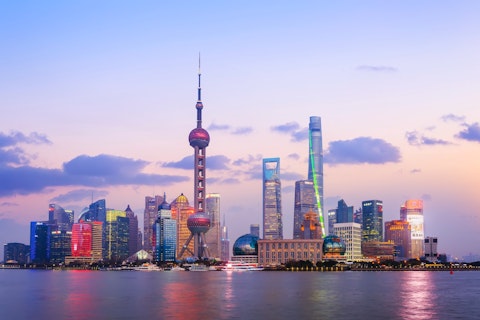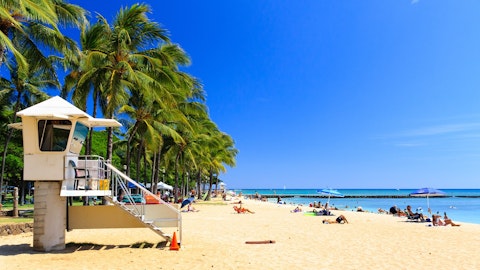In this article, we will look at 36 countries with deflation or dangerously low inflation. If you want to skip our detailed analysis, head straight to 10 Countries with Deflation or Dangerously Low Inflation.
Deflation or Dangerously Low Inflation
While some of the most developed countries in the world including the US and many European countries suffer from high increases in consumer and energy prices, a few countries are facing deflation. When prices of consumer items go down, it is generally taken as a positive sign as the purchasing power of consumers increases and currencies gain value. However, too much deflation can be problematic for economies. It can stagnate economic growth, result in increased unemployment, lead to an increase in interest rates, and also result in lower economic output.
Deflation can be a complex phenomenon. Initially, it will seem good but with time it will get worse and negatively impact the economy. According to a research study ‘The Costs of Deflations: A Historical Perspective,’ the perception regarding deflation that it is very costly is mainly shaped by the Great Depression, and especially by the US experience. During the Great Depression in the US, there was a period when stock and house prices saw an increase, a credit surge, and robust output growth was recorded. The inflation rates and interest rates were low and productivity was strong. This period of apparent productivity ended with the Wall Street Crash of October 1929. A striking financial and economic meltdown followed, leading to bank panics, mass unemployment, asset price collapses, real economic contraction, and dramatic goods and services price deflations in many countries. As per the study, the real output in the US plunged by approximately one-third and consumer prices by almost a quarter between 1929 and 1933. During the same period, nominal wages also dropped by nearly one-fifth in the US, while the unemployment rate soared from 3% to a whopping 25%. As per the study sample, 15 other economies also suffered deflation with a drop in output, goods, and services prices, and asset prices also fell substantially. Among these economies, the median drop in real output was around 7% between 1929 and 1933, much smaller compared to the US. The median decline in house prices across economies was 22% between 1929 and 1933. You can also take a look at the richest countries during the Great Depression.
One of the most prominent examples of deflation in recent times is Japan. The Asian country suffered persistent deflation with a cumulative fall in consumer prices of almost 4% between 1998 and 2012, as per the research in ‘The Costs of Deflations: A Historical Perspective’. According to another study by the Asian Development Bank Institute, Japan’s real estate and stock market collapsed in the early 1990s and the economy went into a tailspin. Since the real estate and the stock market bubble burst, Japan’s economy faced sluggish economic growth and recessions, also known as ‘Japan’s Lost Decade.’ During 1995 and 2002, Japan’s annual real gross domestic product growth averaged only 1.2%, which was lower than the rest of the largest economies in the world at that time.
Just like inflation, which is caused by government policy and economic changes, deflation also gets impacted by a change in government policy which leads to a change in consumer spending. However, there are multiple causes for an economy to fall into deflation including a decrease in the money supply due to tight monetary policy, a decline in consumer demand due to low prices, and improved business productivity with technological advancement that can lead to higher supply and lower cost. Consumers tend to delay purchasing when they anticipate a further decline in prices, decreasing overall demand. With the decline in demand, businesses suffer, which leads to unemployment and wage cuts. Technological innovation is another big contributor to deflationary pressures in an economy. Technological advancement boosts productivity faster than prices are falling. As mentioned in the Asian Development Bank’s ERD Policy Brief Series Risk of Deflation, when a low-cost producer expands its global market share rapidly, the consumer and producer costs go downhill, as in the case of economic expansion of the US markets between 1870 and 1900, or as China’s ongoing growth. That is one of the reasons we see Chinese e-commerce companies dominating the wholesale market such as Alibaba Group Holding Limited (NYSE:BABA). Here is what the ERD Policy Brief Series said about the risk of deflation:
“Deflation can be benign and accompanied by strong economic growth. It can also lead to a downward spiral in output, employment, and demand, in a context where normal policy options cannot be effected. This is particularly true when debt levels are already high. Consequently, the best policy is to preempt deflation. When it is too late to prevent deflation, aggressive monetary easing through innovative methods may become necessary. While the dangers of deflation are not severe at present, a watchful policy stance is advisable.”
China is a perfect example of an economy with deflation or dangerously low inflation. In 2023, China recorded a successive series of declines in its CPI, which began to fall in January 2023 and continued till July 2023, dropping from 104 points in January to 102.7 points in July. CPI improved for the next two months but dropped again in October and November 2023. In December 2023, it marked the longest streak of CPI declines in China since 2009. Similarly, the producer price index (PPI) has been in contraction for more than a year. According to Bloomberg Economics, the biggest contributor to the decline in CPI in China was falling food prices as the food prices plunged for six consecutive months from July 2023 to December 2023, dropping from -0.155 to -0.618. Among food, pork prices saw the biggest decline which plunged 26% in December 2023.
Another big economic issue in China is its property market crisis. On January 30, The New York Times reported that China’s home sales dropped by 6.5% and real estate development plunged by 9.6% in 2023, as per the Chinese investment bank, Dongxing Securities Corp Limited (SHA:601198). In December alone, property sales were down by 17.1% year-over-year. The chief economist at Natixis, Alicia Garcia Herrero said the property market has not touched bottom yet. Herrero emphasized, “There is still a long way to go.” The property market crash in China has impacted many firms and over 50 Chinese property firms have defaulted on debt, including the two market giants: The China Evergrande Group (OTC:EGRNQ) and Country Garden Holdings Co Limited (HKG:2007).
Thailand is another Asian country facing deflationary pressures and is one of the biggest economies with the lowest inflation rates in the world. On February 5, Reuters reported that Thailand’s Prime Minister Srettha Thavisin has asked the Central Bank to ease monetary policy as the country shows economic weakness following four consecutive months of negative inflation. In January 2024, the headline CPI in Thailand dropped by 1.11% year-over-year compared to the forecasted drop of 0.82%. The Governor of the Bank of Thailand (BOT), Sethaput Suthiwartnarueput believes that the current policy rate was “broadly neutral” and the economy was not in crisis, despite government pressure to ease monetary policy.
Chinese Property Giants Suffer
China Vanke Co., Ltd. (HKSE:2202), China Evergrande Group (OTC:EGRNQ), and Country Garden Holdings Co Limited (HKG:2007) are some of the largest real estate companies in China facing serious threats of fulfilling their debts. The property market slump weakens consumer confidence and demand, which plays a significant role in deflation. The Chinese property developers have taken massive debts, while the slowdown in the market has caused defaults. Deflation greatly impacts debt as it increases debt burdens and discourages investment. On March 1, CNBC International posted a video addressing the Chinese property market bubble burst. Chinese property developers are taking desperate measures to recover the market and attract consumers. Here is what CNBC journalist Gaelle Legrand said:
“Desperate property developers in China have resorted to gifts like new cars, free parking spaces, phones, and other consumer goods to attract homebuyers and boost flagging sales. These incentives are just the tip of the iceberg in a crisis involving hundreds of billions of dollars in home builder debt, trillions in local government debt, and at least a billion empty apartments.”
The Chinese property market crisis has impacted massively on the economy. Grace Ng, Senior Economist for Greater China at JPMorgan Chase & Co. (NYSE:JPM) said:
“The weak housing market points at softness in rental cost in CPI components. Plus, auto price cuts and falling pork prices due to oversupply are adding further pressure on the deflation risk.”
China Vanke Co., Ltd. (HKSE:2202) is one of the largest residential real estate developers in China. On March 5, the South China Morning Post reported that China Vanke Co., Ltd. (HKSE:2202) has pledged to repay its outstanding offshore debts due March 11, 2024. The company is prepared to repay a bond worth $630 million.
China Evergrande Group (OTC:EGRNQ) is another leading Chinese property developer. On January 29, Al Jazeera reported that China’s struggling real-estate giant has been ordered to liquidate, as per the Hong Kong court ruling. China Evergrande Group (OTC:EGRNQ) failed to convince the jury that it had a workable plan to restructure approximately $300 billion in debts. This is massive news as property giants suffer huge blows in the second-largest economy in the world.
Country Garden Holdings Co Limited (HKG:2007) is a top property development company based out of Guangdong, China. On January 23, the South China Morning Post reported that Country Garden Holdings Co Limited (HKG:2007) has listed five properties for sale in Guangdong’s provincial capital, including two office towers, a hotel, a residential building, and commercial property. Country Garden Holdings Co Limited’s (HKG:2007) Phoenix City Hotel is valued at $181.5 million. The company has listed its properties for sale as it is in dire need of cash to repay its debts.
With this context, let’s take a look at the countries with deflation or dangerously low inflation.
Our Methodology
To gather the list of the countries with deflation or dangerously low inflation, we took the data for the inflation rate from The Global Economy, updated as of 2023 and 2024. We have shortlisted countries with inflation rates of less than 2%. In addition, we have gathered the real GDP growth rate and unemployment rate of the countries to give an idea of the overall economy. The real GDP growth rate reflects how swiftly a country’s economy is expanding or contracting in case of slow economic growth. We have ranked countries in descending order of their inflation rates. The data for the real GDP growth rate was taken from the International Monetary Fund (IMF) database and the unemployment rate data was taken from the World Bank.
Note: For some countries data for real GDP growth rate and unemployment rate was not available on the IMF and World Bank databases, in that case, we sourced data from Trading Economics.
36 Countries with Deflation or Dangerously Low Inflation
36. Guyana
Inflation Rate (Dec 2023): 1.98%
Real GDP Growth Rate (2024): 26.60%
Unemployment Rate (2022): 12.30%
Guyana has a high real GDP growth rate of 26.60%. Guyana has an unemployment rate of 12.30% and an inflation rate of 1.98%. Guyana ranks 36th among the countries with deflation or dangerously low inflation.
35. Libya
Inflation Rate (Oct 2023): 1.96%
Real GDP Growth Rate (2024): 7.50%
Unemployment Rate (2022): 19.30%
Libya has been struggling since the fall of Muammar Qaddafi and the political instability makes it worse. Libya has an alarming unemployment rate of 19.30% and a low inflation rate of 1.96%.
34. Jordan
Inflation Rate (Jan 2024): 1.95%
Real GDP Growth Rate (2024): 2.70%
Unemployment Rate (2022): 19.20%
Jordan is ranked 34th among the countries with deflation or dangerously low inflation. Jordan has an inflation rate of 1.95% and a real GDP growth rate of 2.70%. Almost 19.20% of people are unemployed in Jordan.
33. Bolivia
Inflation Rate (Jan 2024): 1.86%
Real GDP Growth Rate (2024): 1.80%
Unemployment Rate (2022): 3.60%
Bolivia has a real GDP growth rate of 1.80% and an unemployment rate of 3.60%. Bolivia has an inflation rate of 1.86% and is one of the countries with the lowest inflation rates in the world.
32. Taiwan
Inflation Rate (Jan 2024): 1.79%
Real GDP Growth Rate (2024): 3%
Unemployment Rate (2024): 3.39%
Taiwan is placed 32nd among the countries with deflation or dangerously low inflation. Comparatively, Taiwan is a stable country with a large economy and a real GDP growth rate of 3%.
31. Mauritania
Inflation Rate (Jan 2024): 1.77%
Real GDP Growth Rate (2024): 5.30%
Unemployment Rate (2022): 10.80%
Mauritania is one of the countries with the lowest inflation in the world. Mauritania has an inflation rate of 1.77%, a real GDP growth rate of 5.30%, and an unemployment rate of 10.80%.
30. Hong Kong
Inflation Rate (Jan 2024): 1.72%
Real GDP Growth Rate (2024): 2.90%
Unemployment Rate (2022): 4.30%
Hong Kong is another Asian economy with one of the lowest inflation rates in the world. Hong Kong has an unemployment rate of 4.30% and a real GDP growth rate of 2.90%.
29. Azerbaijan
Inflation Rate (Jan 2024): 1.68%
Real GDP Growth Rate (2024): 2.50%
Unemployment Rate (2022): 5.70%
Azerbaijan has a high unemployment rate of 5.70% compared to the real GDP growth rate of 2.50%. Azerbaijan’s 1.68% inflation rate makes it one of the countries with deflation or dangerously low inflation.
28. Saudi Arabia
Inflation Rate (Jan 2024): 1.55%
Real GDP Growth Rate (2024): 4%
Unemployment Rate (2022): 5.60%
Saudi Arabia is one of the emerging economies in the Middle East. Saudi Arabia is backed by its oil economy and has a real GDP growth rate of 4%. Saudi Arabia has a low inflation rate of 1.55%.
27. Switzerland
Inflation Rate (Jan 2024): 1.50%
Real GDP Growth Rate (2024): 1.80%
Unemployment Rate (2022): 4.30%
Switzerland has an inflation rate of 1.50% and an unemployment rate of 4.30%. Switzerland’s economy is currently growing at a very slow rate of 1.80%.
26. Malaysia
Inflation Rate (Jan 2024): 1.47%
Real GDP Growth Rate (2024): 4.30%
Unemployment Rate (2022): 3.60%
Malaysia has an inflation rate of 1.47% and an unemployment rate of 3.60%. Malaysia’s economy is currently growing at a rate of 4.30%.
25. Ecuador
Inflation Rate (Jan 2024): 1.36%
Real GDP Growth Rate (2024): 1.80%
Unemployment Rate (2022): 3.80%
Ecuador has an unemployment rate of 3.80% and an inflation rate of 1.36%. Ecuador has a real GDP growth rate of 1.80%.
24. Finland
Inflation Rate (Feb 2024): 1.25%
Real GDP Growth Rate (2024): 1%
Unemployment Rate (2022): 6.70%
Finland has an unemployment rate of 6.70% and an inflation rate of 1.25%. With a real GDP growth rate of 1%, Finland ranks 24th among the countries with deflation and dangerously low inflation.
23. Liechtenstein
Inflation Rate (Feb 2024): 1.22%
Real GDP Growth Rate (2009): -1.20%
Unemployment Rate (2022): 1.30%
Liechtenstein is located between Austria and Switzerland. Liechtenstein has an inflation rate of 1.22% and an unemployment rate of 1.30%.
22. El Salvador
Inflation Rate (Jan 2024): 1.21%
Real GDP Growth Rate (2024): 1.90%
Unemployment Rate (2022): 3%
El Salvador is one of the countries with deflation or dangerously low inflation. El Salvador has an inflation rate of 1.21% compared to a real GDP growth rate of 1.90% and an unemployment rate of 3%.
21. Lithuania
Inflation Rate (Jan 2024): 1.08%
Real GDP Growth Rate (2024): 2.70%
Unemployment Rate (2022): 6%
Lithuania has an unemployment rate of 6% with a slow real GDP growth rate of 2.70%. Lithuania has an inflation rate of 1.08% and is one of the countries with the lowest inflation rates in the world.
20. United Arab Emirates
Inflation Rate (Jun 2023): 1.03%
Real GDP Growth Rate (2024): 4%
Unemployment Rate (2022): 3%
The United Arab Emirates is one of the richest Arab countries with an inflation rate of 1.03%. The United Arab Emirates has an unemployment rate of 3% and a real GDP growth rate of 4%.
19. Macao
Inflation Rate (Jan 2024): 1.01%
Real GDP Growth Rate (2024): 27.20%
Unemployment Rate (2022): 2.40%
Macao is a Special administrative region of China with an inflation rate of 1.01%. Macao has a real GDP growth rate of 27.20% and an unemployment rate of 2.40%. Macao’s economic situation is more stable due to low unemployment and a higher growth rate. Macao ranks among the countries with deflation or dangerously low inflation.
18. Denmark
Inflation Rate (Jan 2024): 0.94%
Real GDP Growth Rate (2024): 1.40%
Unemployment Rate (2022): 4.40%
Denmark is one of the few European countries with deflation or dangerously low inflation. Denmark has a low inflation rate of 0.94% and a real GDP growth rate of 1.40%.
17. Italy
Inflation Rate (Feb 2024): 0.92%
Real GDP Growth Rate (2024): 0.70%
Unemployment Rate (2022): 8.10%
Italy has an unemployment rate of 8.10% and an inflation rate of 0.92%. With a real GDP growth rate of 0.70%, Italy ranks 17th among the countries with deflation and dangerously low inflation.
16. Trinidad and Tobago
Inflation Rate (Dec 2023): 0.73%
Real GDP Growth Rate (2024): 2.20%
Unemployment Rate (2022): 3.80%
Trinidad and Tobago has a low inflation rate of 0.73% and an unemployment rate of 3.80%, which is higher than its real GDP growth rate of 2.20%. Trinidad and Tobago ranks among the countries with deflation or dangerously low inflation.
15. Bahrain
Inflation Rate (Apr 2023): 0.72%
Real GDP Growth Rate (2024): 3.60%
Unemployment Rate (2022): 1.30%
Bahrain has a real GDP growth rate of 3.60% and an unemployment rate of 1.30%. Bahrain has a low inflation rate of 0.72% and ranks 15th among the countries with deflation or dangerously low inflation.
14. Latvia
Inflation Rate (Feb 2024): 0.67%
Real GDP Growth Rate (2024): 2.60%
Unemployment Rate (2022): 6.80%
Latvia has a real GDP growth rate of 2.60% and an unemployment rate of 6.80%. Latvia has an inflation rate of 0.67% and is one of the countries with the lowest inflation rates in the world.
13. Brunei
Inflation Rate (Dec 2023): 0.65%
Real GDP Growth Rate (2024): 3.50%
Unemployment Rate (2022): 4.50%
Brunei has an unemployment rate of 4.50% and an inflation rate of 0.65%. Brunei has a real GDP growth rate of 3.50%.
12. Mali
Inflation Rate (Jan 2024): 0.52%
Real GDP Growth Rate (2024): 4.80%
Unemployment Rate (2022): 3.10%
Mali has an inflation rate of 0.52% and a real GDP growth rate of 4.80%. The unemployment rate is around 3.10% in Mali.
11. Georgia
Inflation Rate (Feb 2024): 0.29%
Real GDP Growth Rate (2024): 4.80%
Unemployment Rate (2022): 11.70%
Georgia has a high unemployment rate of 11.70% while it has an above-average real GDP growth rate of 4.80%. Georgia has an inflation rate of 0.29% and is one of the countries with the lowest inflation rates in the world.
Click here to see 10 Countries with Deflation or Dangerously Low Inflation.
Suggested Articles:
- Gold Hits Record High: 30 Countries That Have the Largest Gold Reserves
- 16 Countries With Most Efficient Public Transportation
- 30 Countries with the Highest GDP in 2023
Disclosure: None. 36 Countries with Deflation or Dangerously Low Inflation is originally published on Insider Monkey.






